With a trickle turning into a flood, we're starting to see EVs in a wide variety of shapes and sizes. Many look just like the conventionally powered vehicle on which they are closely based. Others look like nothing else on the road. Some are very small. Others are very large and weigh so much that they might crack driveways. But a core group has formed with its own sheetmetal but shaped and sized to fit in what has been emerging as the largest class of passenger vehicles worldwide: the lower-midsize crossover. Think Honda CR-V or Toyota RAV4--their respective makes' top sellers--but powered by electricity and usually much more innovative. Or, rather, think Hyundai Ioniq 5 and Volkswagen ID.4.
Note the numbers. It seems that, with EVs, most auto makers have decided to do away with names. Or at least multiple names. All of Hyundai's EVs will be Ioniq-space-#. At VW, they'll all be ID-dot-#. (This site's code isn't set up for having a dot as part of a model name--no one's done this before--so in our database the first available here is the ID4.) This comparison pits the #5 Ioniq against the #4 ID. Is this a case of 5 being a larger number than 4, or of 4th being a better finish than 5th?
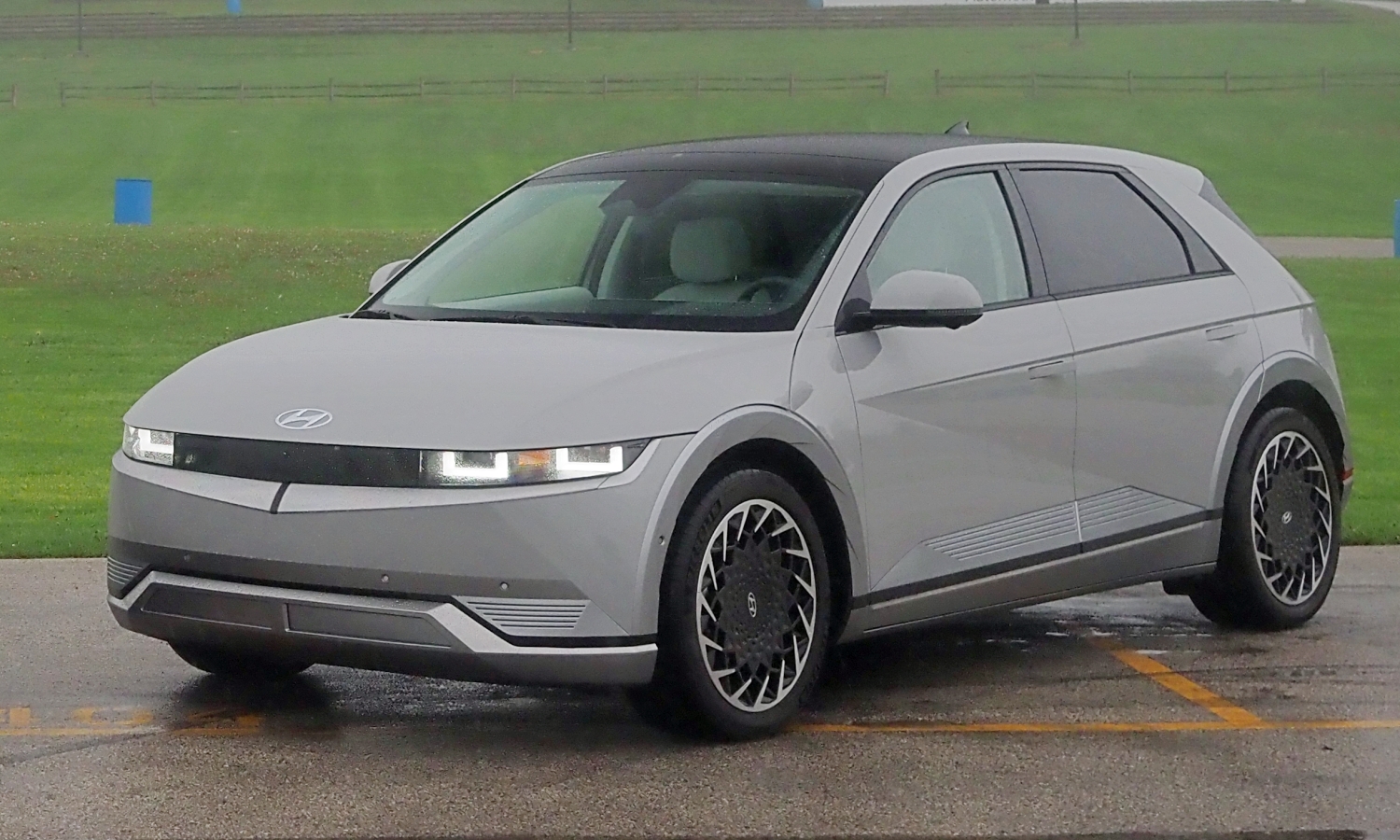
Retro 1970s hatchback with 2030s tweaks. Korea has learned to speak Italian. more Ioniq 5 photos
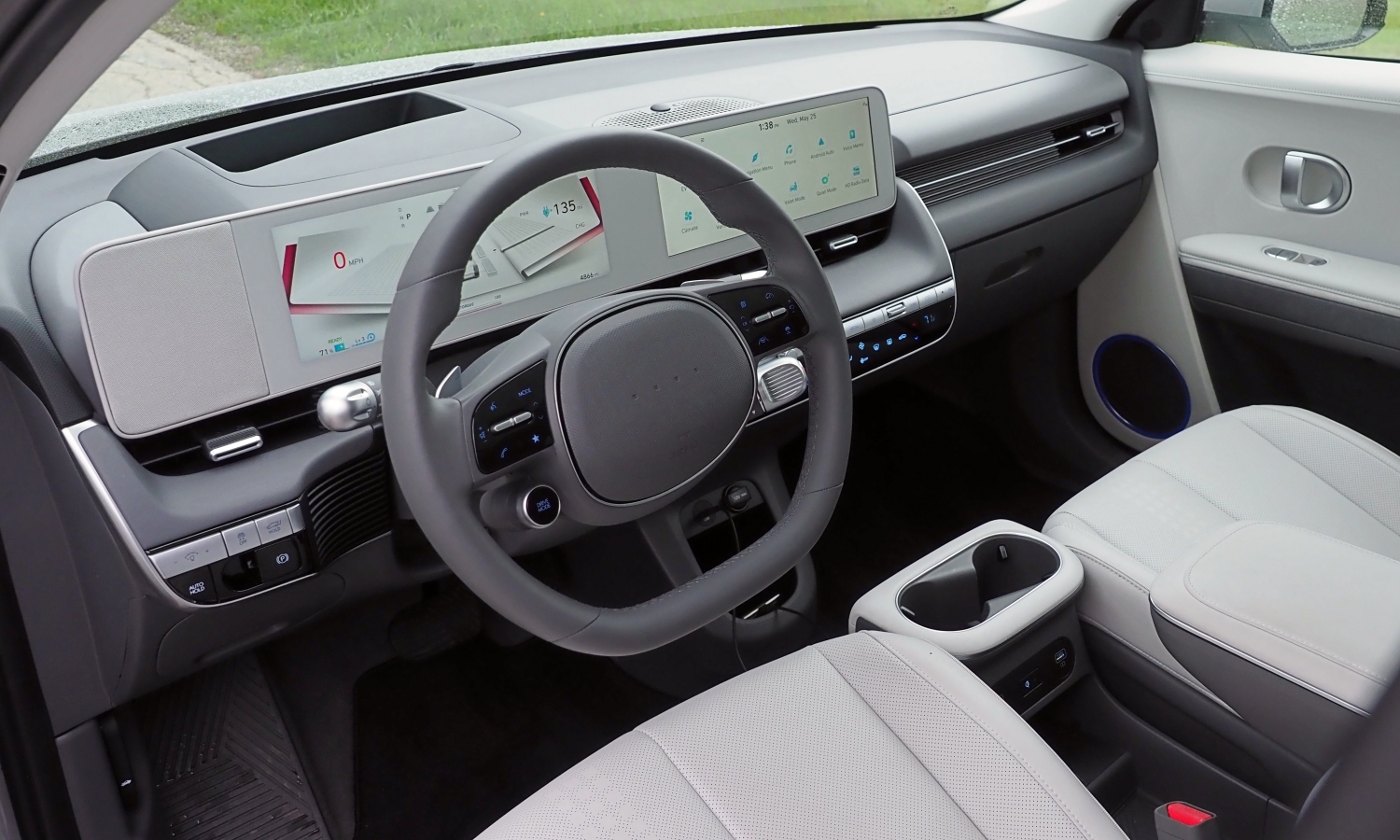
Hyundai's interior concept was "smart living room." White has never worked better in a car interior.
| |
Compared to the ID4 |
| Exterior styling |
 Better
Worse
Better
Worse
|
Five minutes after seeing a Volkswagen ID.4--perhaps sooner--I can no longer recall what it looks like. It's not quite generic, as something entirely generic would be memorable as entirely generic. But no aspect of its amorphous exterior forms an impression.
Hyundai's designers, on the other hand, had a clear idea of the look they were going for--a dramatically updated 1970s Italdesign hatchback with perfect proportions and retro-futuristic lighting--and nailed it. Even the diagonal line through the faceted body side that appears so awkward on the Hyundai Elantra works perfectly here.
Compared to the Volkswagen, the Hyundai is two inches longer (182.5 vs. 180.5 inches) but has a wheelbase nearly ten inches longer (a minivan-like 118.1 vs. 108.9), yielding far more athletic proportions. The Hyundai's roof is also an inch-and-a-half lower (63.0 vs. 64.6).
A further sign that Hyundai's designers got the proportions they wanted? (The Toyota Supra's designers are quite jealous.) While the Ioniq 5 shares an architecture with the Kia EV6 and Genesis GV60 (more EVs without unique names), it shares key dimensions with neither. Both of the others ride on a 114.2-inch wheelbase. But the Kia is a couple inches longer and a couple inches lower--it's barely tall enough to qualify as a crossover at all--while the Genesis is four inches shorter and a half-inch lower (and so similarly proportioned, just smaller and much rounder). To me, the EV6 appears bloated, especially in the tested shade of red, while the GV60 could be a bit much of a nondescript egg (though I do like the ultra-clean integration of its headlights and tail lights). Of the three, the Ioniq 5 has the most striking appearance even without a fashionably angry face or any tacked-on "look at me!" details.
| Interior styling |
 Better
Worse
Better
Worse
|
Hyundai's designers also had a clear and distinctive concept guiding their work inside the Ioniq 5: clean, light, open, and airy. So clean. If Apple designed an instrument panel, it would look much like the Ioniq 5's.
Though the Kia EV6 is closely related, it feels very different inside due to a lower seating position, a taller and more intrusive center console, and a colder, darker ambiance. The Kia's materials also looked and felt cheaper to me, but this could have been due to the difference in concept. The Jaguaresque interior of the Genesis GV60, on the other hand, looks and feel the most luxurious--as it should--and it is filled with interesting details. The drive selector even transforms into a crystal ball when the GV60 is off, making it clear whether the car is turned on. But its look isn't as distinctive.
The Ioniq 5 does seem more a family hauler, but in a good way. An extended version with a third row would appeal to many people.
From the driver seat the VW ID.4 seems even more a family hauler, but in a somewhat off-putting way. Though the style is generic mildly upscale, with more than a hint of BMW in its faceted surfaces and horizontal emphasis, I felt like I was inside a transportation pod, an appliance. The only things really new here we'll get to in a bit.
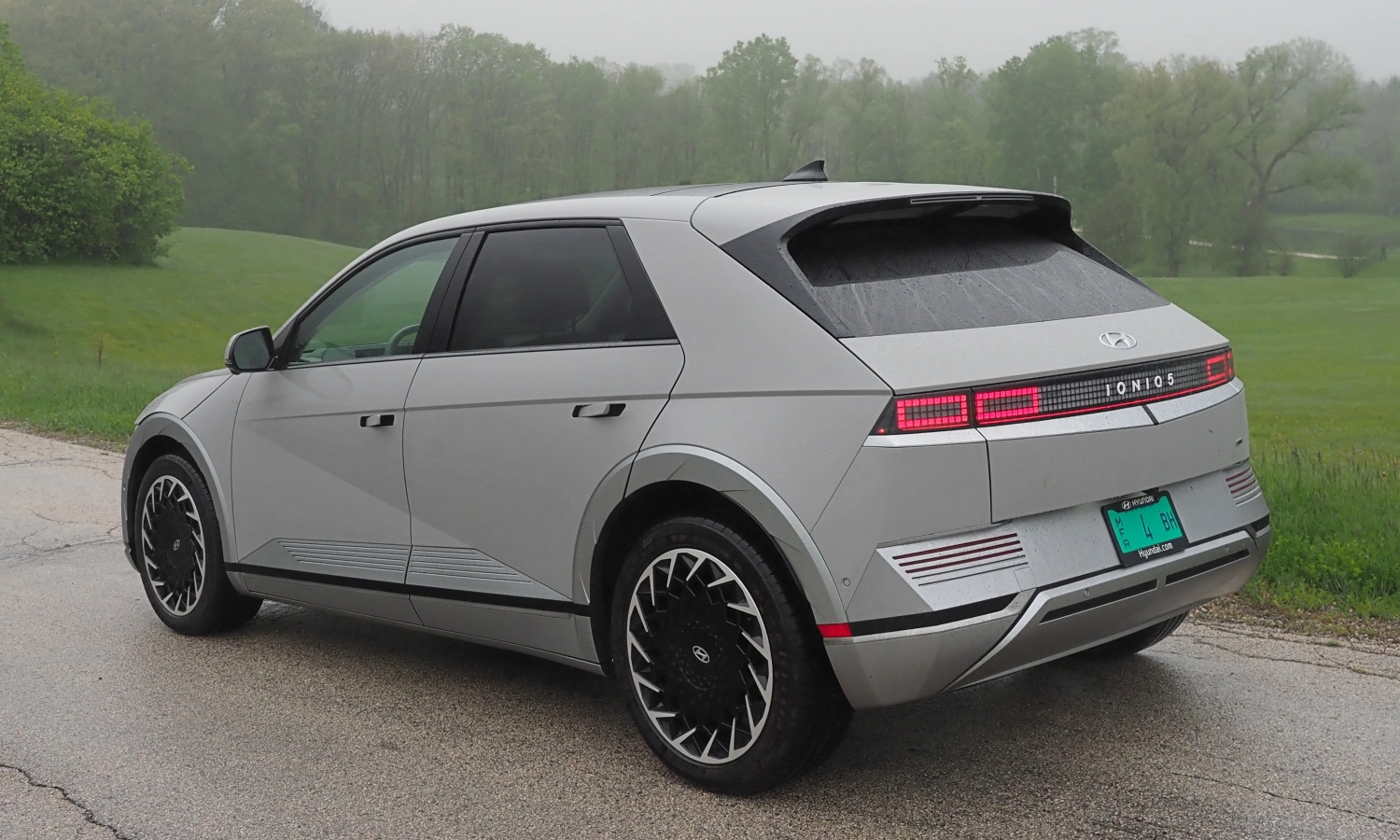
Unlike with the Elantra, a diagonal character line through the body side works here.
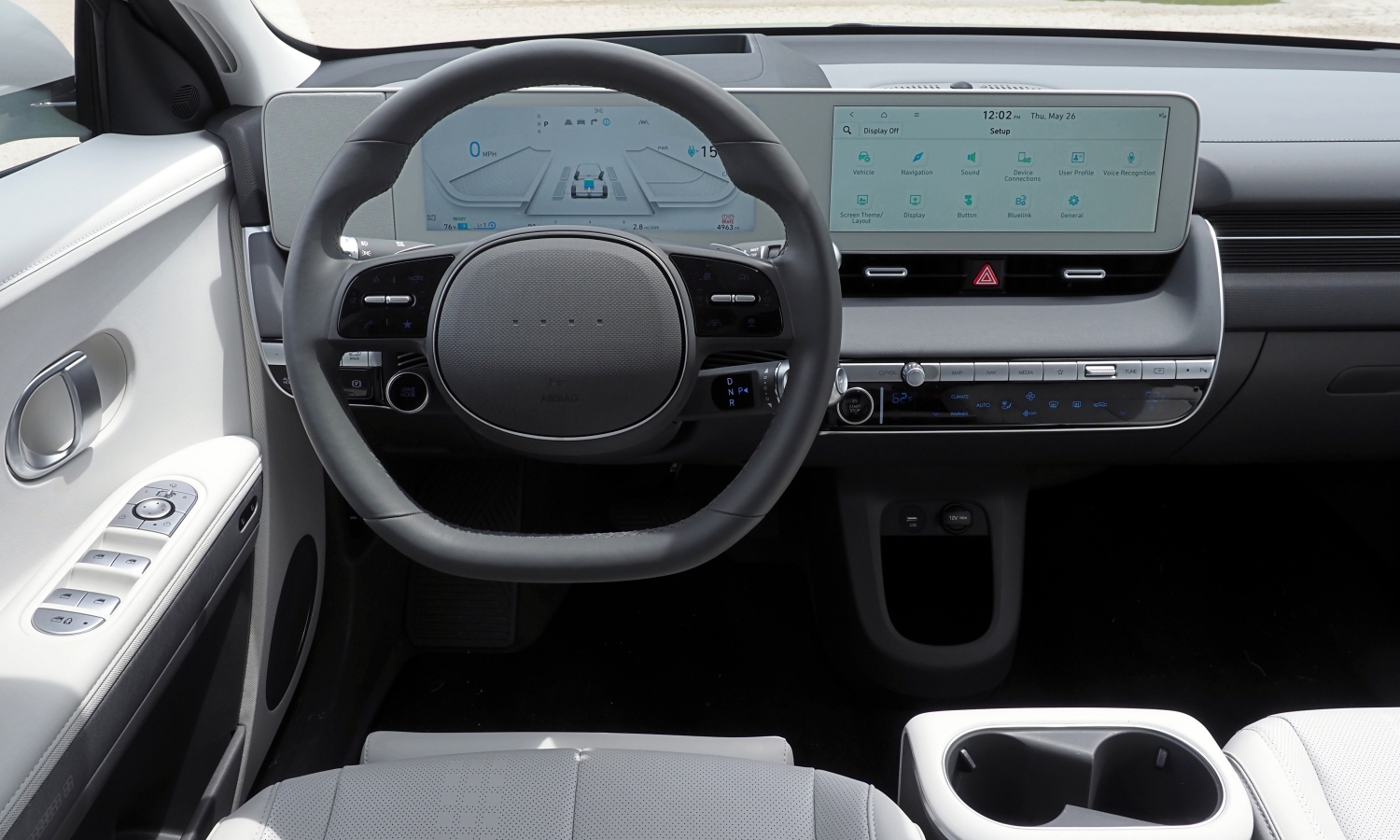
If Apple designed an instrument panel. Looks good, works well.
| Driving position & visibility |
 Better
Worse
Better
Worse
|
Differences in their driving positions played a role in my differing opinions of the Ioniq 5's and the ID.4's interior styling. That in the Hyundai is just about perfect. The seating height roughly splits the difference between that in a sedan and that in the average crossover. You sit higher in the VW. But, despite sitting lower in the Hyundai, you don't feel buried in it (I did feel a bit buried in the related Kia EV6) because the base of the windshield is also lower than in the Volkswagen. Due to differences in design, while the instrument panel is quite deep in both EVs, it appears much deeper in the ID.4 than in the Ioniq 5. The VW's tiny instrument cluster doesn't help here.
Owing much to this driving position, but also well-finessed chassis tuning, the Hyundai simply feels right on the road. It doesn't quite feel sporty, and feedback from the steering (as in 99% of current cars) could be more thorough, but the way the vehicle moves when you turn the wheel is exactly how you want it to move. Quite pleasant and satisfying, and on a curvy road even a bit fun. The Kia and Genesis might feel a touch sportier--any differences in how the three handle are minor--but owing to their sportier styling I had different expectations of them. (The more aggressively tuned 576-horsepower EV6 GT likely delivers on these expectations.)
The VW I didn't connect with nearly as well. The ID.4's steering ratio felt surprisingly quick, but this seemed out of synch with the otherwise benign handling and character of the vehicle.
| Fuel economy |
 Better
Worse
Better
Worse
|
The Hyundai Ioniq 5's fuel economy and range are only about average for this class of EV: the equivalent of 110 mpg in the EPA's city test, 87 in the highway test, and 250 miles of range in mixed driving. These are 2022 figure--2023 figures haven't been released yet. The model year matters because EVs' efficiency often improves as their manufacturers discover beneficial tweaks and make updates, some of which could be made via software to those already on the road. The MPGe figures for the ID.4 improved from 98/88 in 2021 to 100/90 in 2022 and 104/93 in 2023, the last with a range of 255 miles.
With either vehicle you'll get less range in the base trims with their smaller battery packs, and more efficiency and another 25-to-50 miles of range with a single motor (which drives only the rear wheels in both cases) compared to the dual motor variants I drove.
In terms of energy efficiency the Ioniq 5 and ID.4 are pretty close. Where they differ is in charging time. Hooked up to a high-powered charger the VW can get from a charge level of 10 percent to 80 percent in as little as 30 or 36 minutes (depending on which of two suppliers made the battery pack). The closer a battery gets to full the more slowly it charges. For this reason, and because it's not good for the batteries to often be charged or discharged completely, EVs are often programmed to stop charging around 80 percent unless the owner directs otherwise.
But I digress. The point I was aiming to make is that the Hyundai, with a higher voltage electrical architecture, when hooked up to a capable charger can charge about twice as quickly as the VW. Hyundai claims it can go from 10 percent to 80 in 18 minutes, and add 68 miles of range in five minutes. This is up among the current best.
| Powertrain performance |
 Better
Worse
Better
Worse
|
Even in 320-horsepower form the Hyundai Ioniq 5 isn't nearly the quickest EV you can buy. Some with more than three times the power are more than twice as quick. But, with the ability to get from zero to 60 mph in a few tenths under five seconds, it's still quicker than all but a few cars you could buy a decade ago, and plenty quick for its mission.
The 295-horsepower VW ID.4 isn't as powerful, especially not at low speeds (as indicated by a torque rating of 339 lb-ft vs. 446), and takes nearly a second longer to get from zero to 60. Still quite quick, but you feel a more vigorous shove when you mat the accelerator in the Hyundai.
In the Ioniq 5, you can select any of four noticeably different driving modes--eco, normal, sport, or snow--using a prominent button on the steering wheel. Any of five levels of regenerative braking, with the most aggressive designed for one-pedal driving, can be selected using the sort of paddles that manually shift the transmission in a conventional car.
The ID.4 also offers multiple driving modes, including one that is customizable, but these must be selected using the touchscreen, so it's not as easy (or as safe) to change them while driving. The VW makes the amount of regen with your foot off the pedals more easily selectable, via the shifter, but offers only two levels, none (D) and some (B). For any variation on these you have to apply the brake pedal.
| |
Compared to the ID4 |
| Reliability & durability |
|
My reservation with both the Hyundai Ioniq 5 and the Volkswagen ID.4 is the same: we don't yet know how long their expensive battery packs will typically last. They're warrantied for eight years, and are probably good for at least a few years more than that. But how many more?
The average car on the road is now more than twelve years old. Since this is the average, for every new car there's one out there in the vicinity of 20 years old. More than a quarter are now at least 16 years old. Will the great majority of EVs go 20 years before being effectively totaled by a battery pack failure? How much do the odds of failure increase as they age past the warranty expiration? We won't know the answers to these questions for at least a few more years.
| Price or payments |
 Better
Worse
Better
Worse
|
Owing to the cost of making their battery packs, these EVs are not inexpensive. Pricing for the 2023 Hyundai Ioniq 5 starts a bit north of $43,000. And this is if you can find one with the small battery pack and 168-horse single motor--Hyundai no longer shows this variant on its website. Jump up to the larger battery and 225 horsepower (but still a single motor driving the rear wheels) and the Ioniq 5 lists for $46,795. As-tested in Limited trim with dual motors ($3,900) and floormats ($195) it lists for $58,990. This is $3,000 more than the 2022 I drove, due to inflation and all of the awards the Ioniq 5 has been winning.
The German VW (made in Tennessee for 2023) costs a bit less than the Korean Hyundai, with a starting price of $40,290. Adding the larger battery adds $5,000. Adding a second motor and AWD adds $3,800. Opt for the top trim level and a paint with some color in it ($395) and the sticker tops out at $56,540.
If the Ioniq 5's various advantages aren't enough to justify the price difference, it's slightly higher feature content might. The top trim has a head-up display (HUD), ventilated seats, and second-row sun shades that you can't get with the ID.4. At least not yet; ventilated seats will be available on the 2024 VW. Both already have many other features when loaded up, including fixed glass roofs, a massage feature in the front seats, memory for driver seat settings, heated steering wheels, and frankly more stuff than it makes sense to run through here. Both have extensive safety tech even in their base trims.
But wait, there's one more wrinkle. The 2023 ID.4, unlike the previous years, is being made in VW's Tennessee plant. This makes it eligible for a $7,500 tax credit. The Hyundai is not eligible. If you qualify for this tax credit the VW's price advantage becomes substantial.
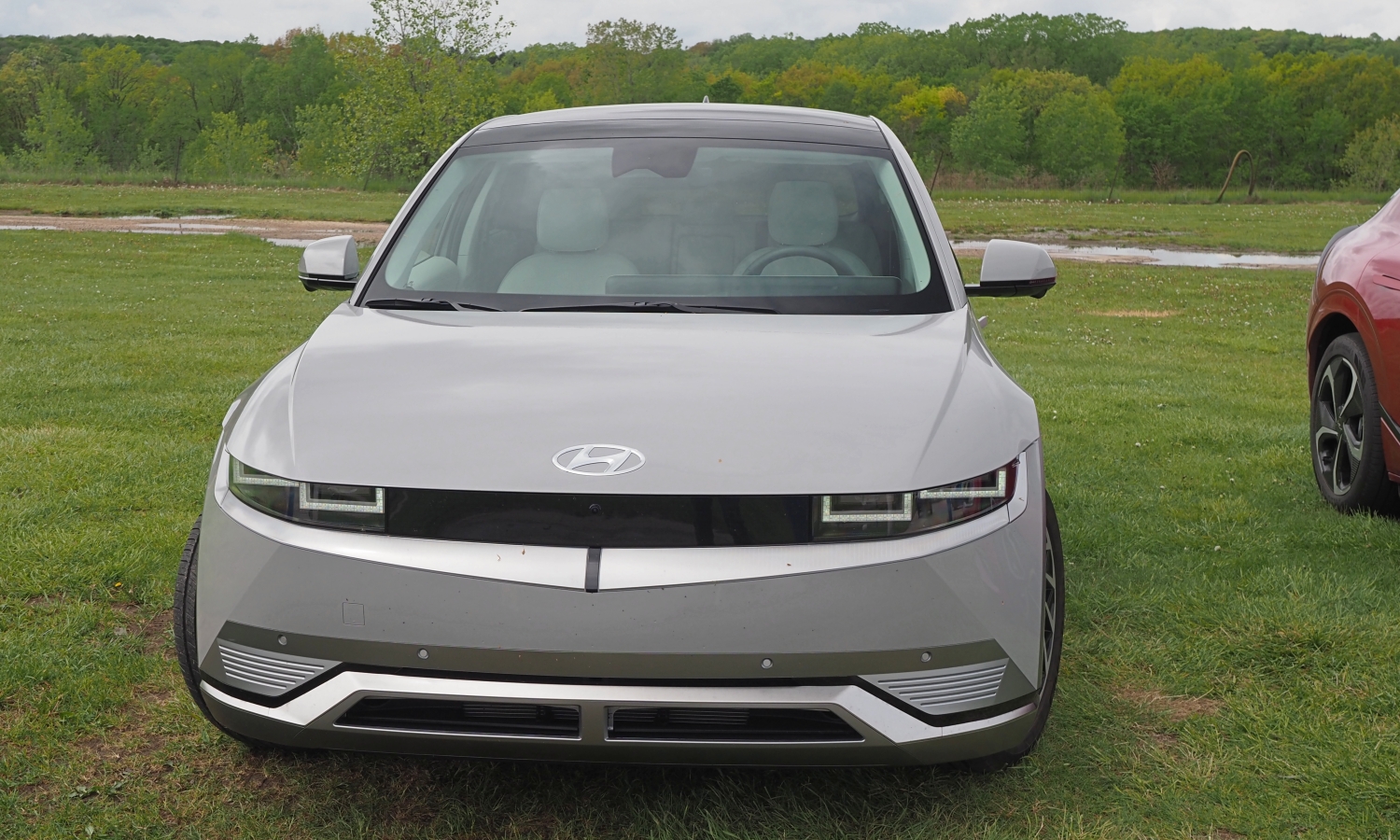
Minimalist, yet really not. The more you look, the more you see.
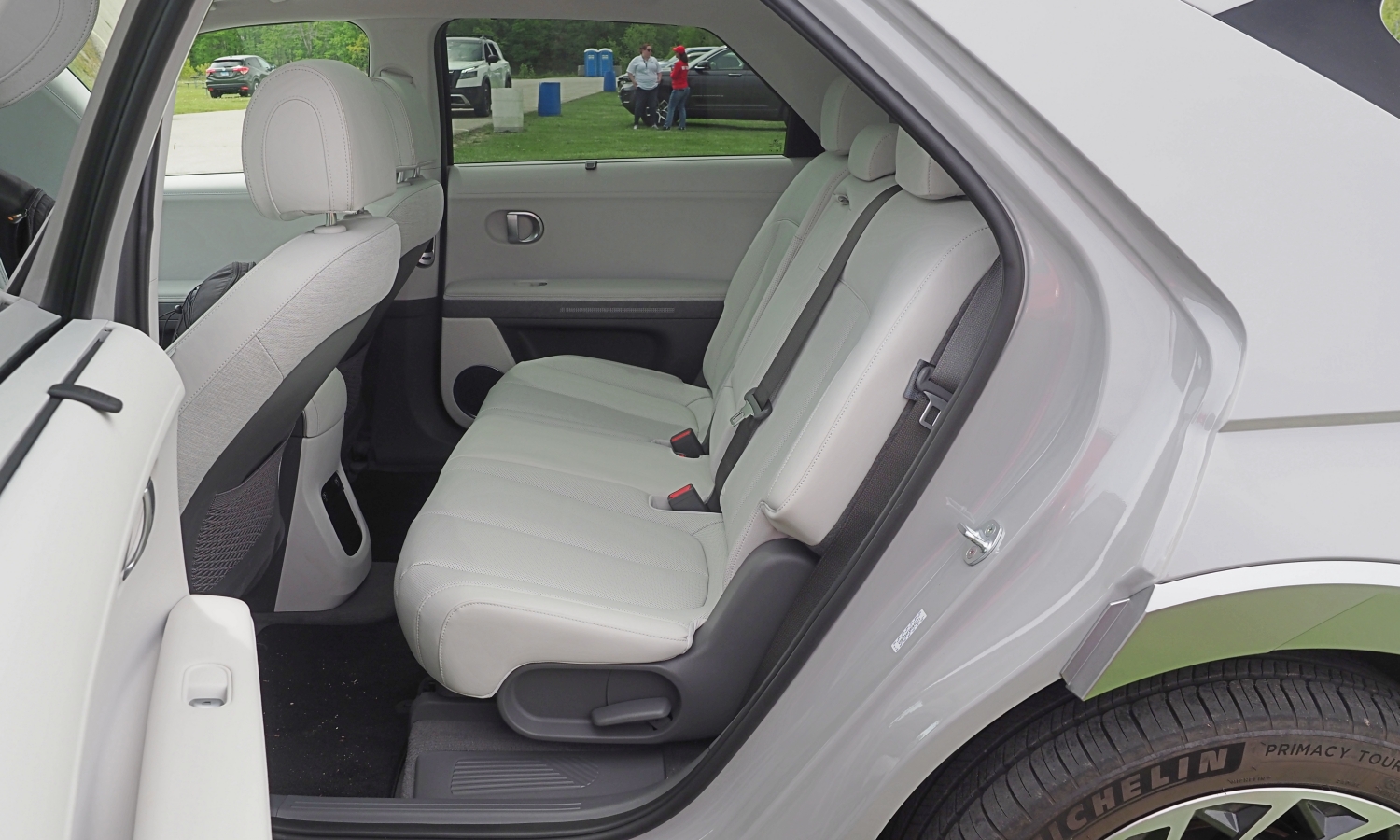
A bit low to the floor, the price of a relatively low roof line.
| Rear seat room & comfort |
 Better
Worse
Better
Worse
|
One of two areas where the Hyundai Ioniq 5 might fall a bit short for its intended function is in rear seat comfort. Not only is there a little more knee room in the rear seat of the ID.4, but the VW's seat is mounted higher off the floor, and so provides better leg support. This is also an issue with the related Kia and Genesis. In the last knee room is marginal for one man of average height sitting behind another. It seems that the lower roof lines on these vehicles are not cost-free.
| Cargo capacity |
 Better
Worse
Better
Worse
|
The other area is cargo capacity. The stylishly truncated rear end of the Ioniq 5 plus its relatively low roof line plus the big battery pack under the floor add up to cargo volume about four-fifths that of a Honda CR-V or Toyota RAV4--or of a Hyundai Tucson. Based on official specs (which can be gamed) the ID.4 can fit a few more cubes. Still enough for nearly all likely buyers nearly all of the time? Most likely.
Then there's the matter of the frunk Tesla has popularized. A peek under the hood suggested that the Ioniq 5 didn't have one. Actually, there's a lidded cargo compartment there that I didn't recognize as such. Perhaps I should have read the large "OPEN" with an arrow pointing towards the lid's latch? Still, there's not much space in there. And there is no compartment at all under the VW's hood (though an internet search will find that some companies will sell you a bin that fits).
| |
Compared to the ID4 |
| Controls and instruments |
 Better
Worse
Better
Worse
|
The Ioniq 5's controls work well enough--Hyundai tends to keep things reasonably simple, intuitive, and easy to use.
This topic is here for the Volkswagen ID.4, which in the latest VW fashion makes extensive use of capacitive touch controls that are difficult to find by feel alone (eyes often must come off the road) and that are overly easy to activate by mistake. Want to lower a rear window from the driver seat? First tap the "rear" touch control, then press one of only two (rather than the usual four) buttons. Also, within the touchscreen interface, a larger number of functions are often more buried than in the Hyundai.
VW has announced that the steering wheel controls at a minimum will be reverting to conventional buttons and switches and that some of the capacitive controls that lack backlighting--making them even harder to find at night--will be gaining it.
A final thing to note about controls: in both EVs forward and reverse are selected using a knob near the steering wheel rim. For D you turn the knob forward, and for R you turn it rearward. Turning the knob in the direction you want the vehicle to go might seem only logical, but it is opposite the way console-mounted shifters have worked for a very long time.
| Ride smoothness |
 Better
Worse
Better
Worse
|
I didn't drive either EV over especially rough roads, but as far as I could tell both rode well even though they're shod with low-profile tires on 20-inch wheels. The Hyundai's suspension might be a little firmer, but its ultra-long wheelbase (for a vehicle its size) helps reduce any fore-aft pitching.
| Quietness |
 Better
Worse
Better
Worse
|
Both EVs are very quiet, as all but the most basic EVs tend to be. There are no powertrain vibrations or noises to detract from a premium feel, and their aerodynamic styling (necessary for good range on the highway) minimizes wind noise. Road noise remains a possibility, but I heard little of it.
It amazes me that EVs are already so good so early in their development. Both Hyundai and VW only got serious about such vehicles about a decade ago, and already they provide thoroughly refined driving experiences.
The Volkswagen ID.4 is a very good vehicle, just a fairly boring one to look at and to drive. The short take in my notes: "Drives like a big, smooth box." One big plus: the 2023 model qualifies for the new $7,500 EV tax credit. The Ioniq 5, since it is not assembled in North America, does not.
Aside from this wrinkle, the Hyundai Ioniq 5 does everything the VW does at least as well and often better, while delighting with its brilliant styling and how it feels when the wheel is turned. I'm only surprised when it doesn't win an award for which it is eligible--which hasn't happened often.
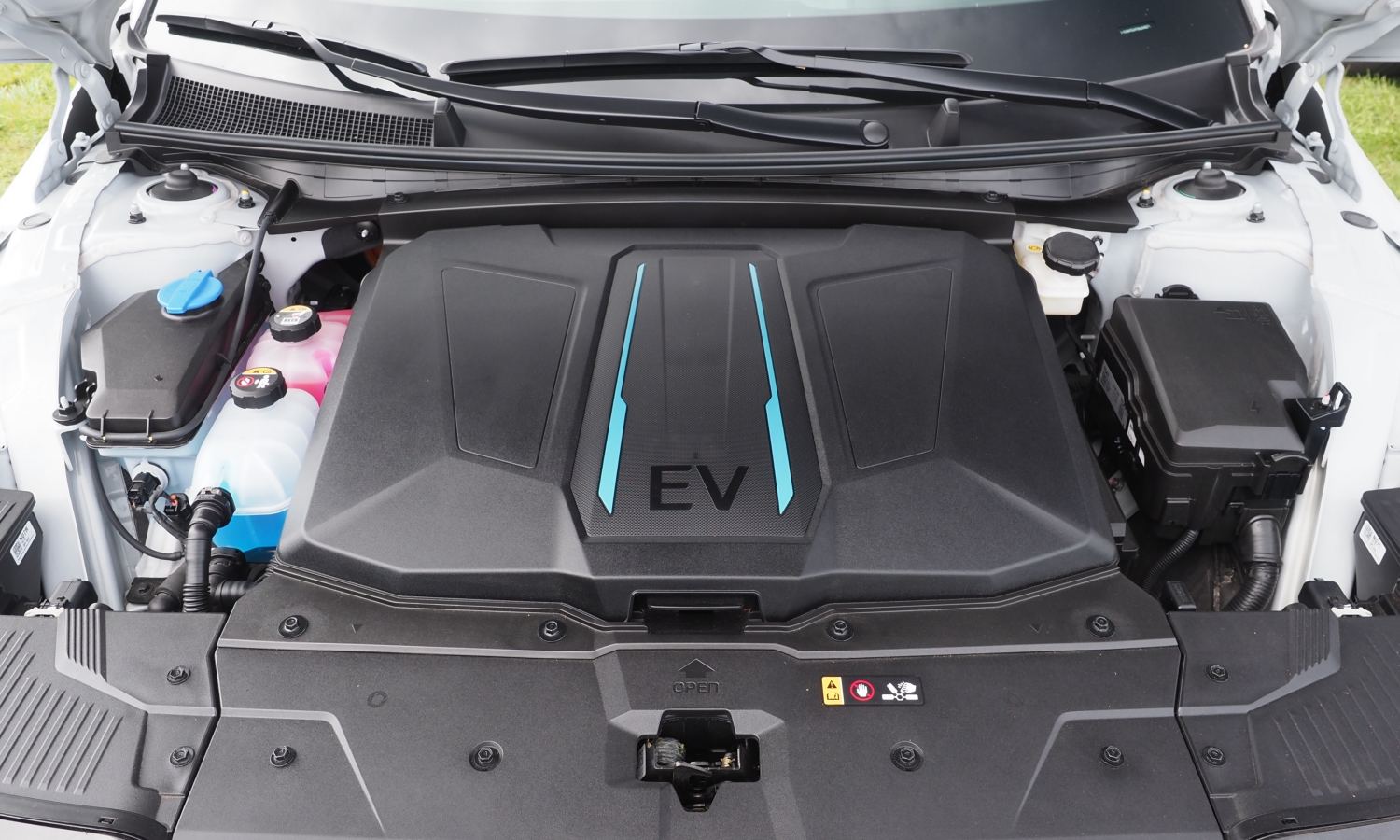
There's some storage in here. The "OPEN" might be a hint.
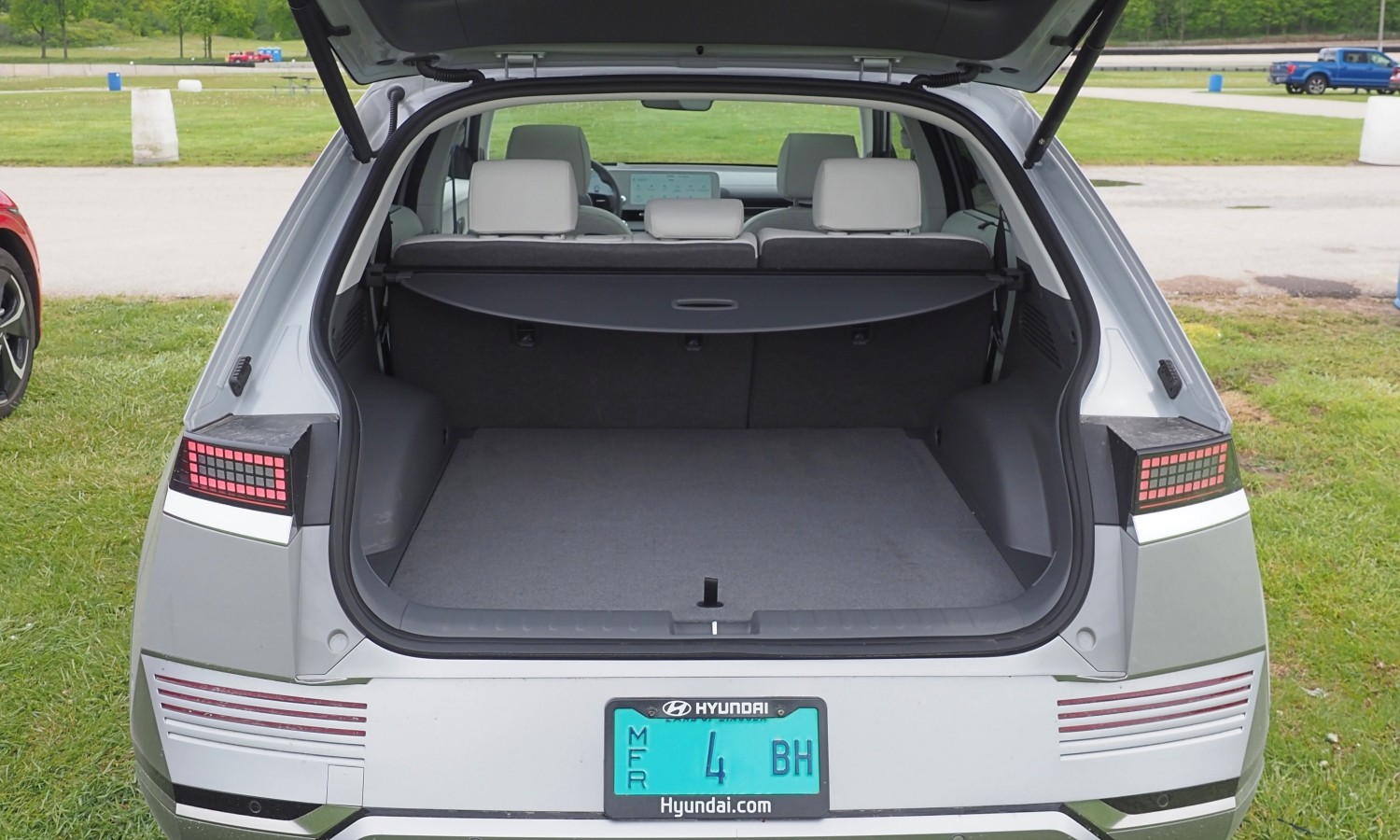
About four-fifths the amount of cargo space of a conventional crossover its size. Note tail lamps.
See more 2022 Hyundai Ioniq 5 photos
Both vehicles were driven at Midwest Automotive Media Association events, and were provided by their manufacturers.











